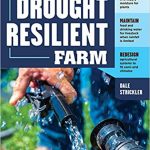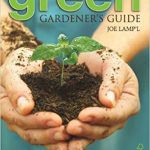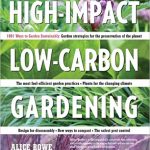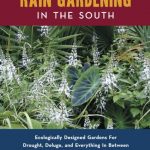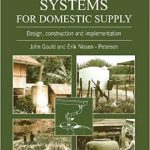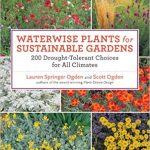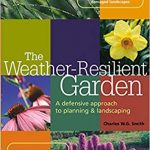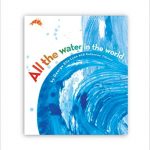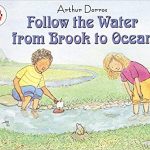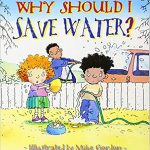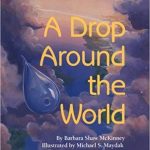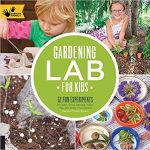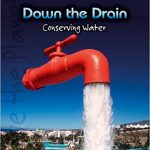Waterwise Gardening
Library Guide
This Waterwise Gardening Library Guide will introduce you to books and web resources to get you started with waterwise gardening, covering topics such as: water conservation and why it matters, basic principles of waterwise gardening, designing and constructing rainwater catchment systems, and inspiring young water-savers.
The books and DVDs listed in this guide are available at the Lora Robins Library at Lewis Ginter Botanical Garden, and can be borrowed by Garden members.
WHAT IS WATERWISE GARDENING?
A waterwise garden is productive and functional, and works with nature and natural forces (like rain) to flourish while conserving water. Reducing the need to water your garden requires a little bit of research and some planning, but you’ll find that a lot of these practices are pretty common sense.
Xeriscaping, or xeriscape landscaping, are terms often used interchangeably with waterwise gardening. The word “xeriscape” is derived from the Greek xēros, meaning “dry,” and the word “landscape.” The Denver Water Department coined and copyrighted the term in an effort to make water-efficient landscaping an easily recognizable and catchy concept.
The 8 fundamentals of waterwise landscaping are outlined as follows:
- Plan your landscape: group plants according to their water needs.
- Prepare your soil adequately. Make sure it’s healthy!
- Use native and low-water-use plants.
- Limit turf areas to those needed for practical uses.
- Use efficient irrigation systems.
- Schedule irrigation wisely.
- Remember to mulch.
- Provide regular maintenance.
WHY GO WATERWISE?
Clean, fresh water is a limited and precious resource that is necessary for life on earth. As global populations surge and temperatures rise, we are consuming our surface water at unprecedented rates. And while access to water and sanitation is a human right, according to the World Health Organization, water scarcity today affects 4 out of every 10 people.
Waterwise gardening offers a number of environmental and economic benefits:
- Reduced water use means lower water bills.
- By conserving water, you personally put less strain on our shared water resources.
- Waterwise gardening practices help preserve habitat for plants, pollinators, and other wildlife.
- By reducing your water use, you’re requiring less pumping and treatment. This translates to reduced energy use and, subsequently, decreased generation of air pollution.
- Using less water reduces runoff of the stormwater and irrigation water that carries topsoils, fertilizers, pesticides, and other pollutants into our streams, rivers, and lakes.
- The use of native plants conserves water and reduces maintenance labor and costs.
- Decreasing your water use extends the life of water resource infrastructure, such as treatment plants and aquifers.
BOOKS FOR ADULTS
The Drought-Resilient Farm by Dale Strickler (2018)
While written for farmers, this book covers a number of water conservation strategies accessible to dedicated home gardeners.
The Green Gardener’s Guide by Joe Lamp’l (2007)
This user-friendly guide provides solutions for gardeners looking to become better stewards of the environment, including ways to reduce water usage, pollution of soil and water, erosion, runoff, and solid waste.
High-Impact Low-Carbon Gardening by Alice Bowe (2011)
This comprehensive reference offers 1,001 ideas for gardening sustainably, from simple tricks to garden-wide makeovers, emphasizing ways to reduce water and yard waste, prevent water pollution, support wildlife, and minimize carbon emissions.
Rain Gardening in the South by Helen Kraus and Anne Spafford (2009)
This user-friendly and comprehensive guide explains how to plan, design, construct, and maintain rain gardens, with plant selections and soil advice suited to the region.
Rainwater Catchment Systems for Domestic Supply by John Gould and Eric Nissen-Petersen (2008)
This technical reference details all aspects of designing and constructing rainwater catchment systems, including step-by-step instructions for building several different rainwater tanks.
Rainwater Collection for the Mechanically Challenged by Suzy Banks with Richard Heinichen (2004)
This handbook breaks down the steps of installing rainwater catchment systems in accessible language supplemented with plenty of diagrams, illustrations, and photographs.
Waterwise Plants for Sustainable Gardens by Lauren Springer Ogden and Scott Ogden (2011)
This clearly-written guide covers 200+ ornamental plants that require minimal water. Each entry includes symbols and text indicating common and botanical names, preference for sun or shade, mature size, bloom periods, and where the plant is best adapted.
The Weather-Resilient Garden by Charles W. G. Smith (2004)
This comprehensive guide offers home gardeners defensive approaches to planning and maintaining gardens capable of bouncing back from weather events. While generally useful, the chapter on drought offers planting and watering strategies, as well as a list of drought-tolerant plants by region.
BOOKS FOR KIDS
All the Water in the World by George Ella Lyon (2011)
A lively, readable poem and brilliant illustrations weave together facts about the water cycle. (Ages 4-8)
Follow the Water from Brook to Ocean by Arthur Dorros (1991)
This book explains how water flows from brooks, to streams, to rivers, over waterfalls, through canyons and dams, to eventually reach the ocean. (Ages 4-8)
Why Should I Save Water? by Jen Green (2015)
Simple text and fun illustrations show children many ways that they and their families can save water. (Ages 4-8)
A Drop Around the World by Barbara Shaw McKinney (1998)
This vivid picture book takes readers on a global journey from the perspective of a single drop of water, connecting plant, animal, and human life through the water cycle. (Ages 5-8)
Gardening Lab for Kids by Renata Fossen Brown (2014)
Help kids grow their own patch of earth with 52 plant-related activities, including watering and measuring rainfall. (Ages 7-10)
Down the Drain by Anita Ganeri and Chris Oxlade (2005)
This book introduces young readers to the concept of water as a precious, limited resource, how water is used, and ways to take action and conserve water. (Ages 8-10)
WEB RESOURCES
Alliance for the Chesapeake Bay Yard Design Tool
This resource is designed to help property owners in the Chesapeake Bay Watershed (including parts of DE, MD, NY, PA, VA, WV, and the District of Columbia) install a rain gardens and conservation landscapes in their yards.
Beautiful RVA Community Greening Toolkit
Beautiful RVA has developed a set of tools to help you begin creating a healthier, more sustainable environment. Resources include landscape design templates, timelines, budget templates, information about native plants, and more.
Chesapeake Bay Landscape Professional Program
Chesapeake Bay Landscape Professional (CBLP) is a system of materials and instruction coordinated across the region, developed to create a community of certified professionals who can be better stormwater partners and environmental stewards.
EPA WaterSense
The Environmental Protection Agency’s WaterSense program labels water-efficient products and serves as a resource for helping you save water.
Landscape for Life
Landscape For Life™ is a collaboration between the Lady Bird Johnson Wildflower Center and the U.S. Botanic Garden based on the principles of the Sustainable Sites Initiative (SITES®). The Water section offers sustainable water management techniques and ways to implement them on your own property.
Lora Robins Library
Discover even more books, DVDs and web resources at the Robins Library at Lewis Ginter Botanical Garden.
Virginia Cooperative Extension
Virginia Cooperative Extension offers educational resources produced in partnership with Virginia Tech and Virginia State University, and the National Institute for Food and Agriculture, an agency of the U.S. Department of Agriculture.
Water Calculator
GRACE Communications Foundation (GRACE) – a non-profit dedicated to creating a more sustainable food system – developed its Water Footprint Calculator to help you estimate your total water use, and learn ways to save water.
